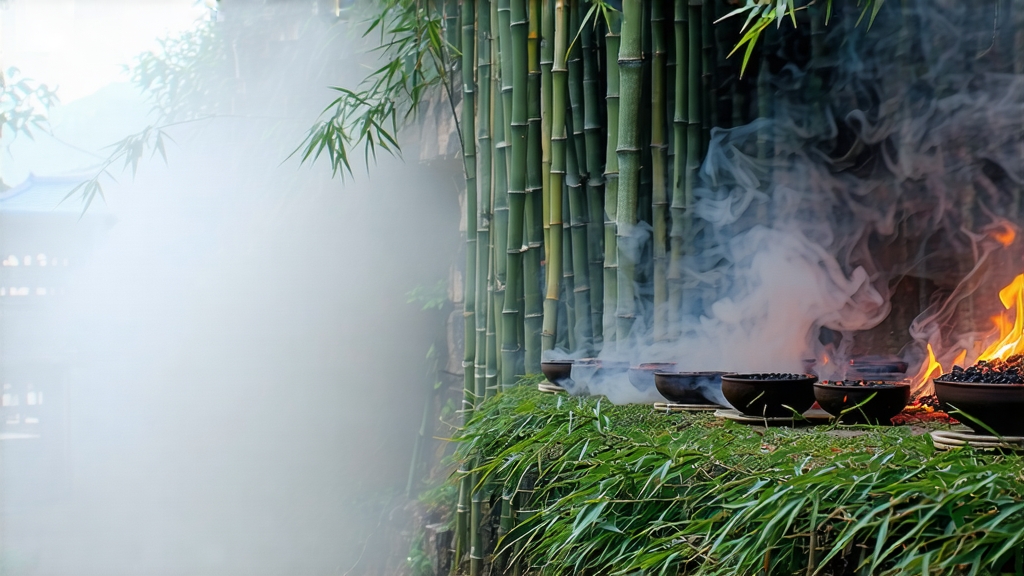
Long before English breakfast tables knew the word “black tea,” caravans loaded with slender, pitch-dark leaves left the granite gorges of northern Fujian. The cargo was called Lapsang Souchong—literally “small leaf from the original mountain”—and it would become the first fully oxidised tea the West ever tasted. Portuguese Jesuits wrote about it in 1602; Dutch merchants auctioned it in Amsterdam in 1606; by the late 1600s it had crossed the Atlantic on East Indiamen, filling Boston’s cups and London’s coffee-houses with a scent that reminded people of camp-fires and candied plums. In China the tea was never merely merchandise; it was the catalyst that taught the world to crave hong cha—“red tea” as the Chinese call it—while remaining a guarded secret of the Wuyi Shan.
Geography is the first chapter of the story. The protected core of the Wuyi Biosphere Reserve is a labyrinth of 90-degree cliffs, subtropical evergreens and a micro-climate trapped by the 36 narrow gorges of the Jiuqu Xi, the “Nine-Bend Stream.” Day-night temperature swings of 15 °C force the indigenous Xiao Ye Zhong (small-leaf cultivar) to grow slowly, thickening cell walls and concentrating sugars. The rocky sub-soil, called “danxia” for its purple sandstone and mineral-rich quartz, delivers a flinty note that connoisseurs translate as “yan yun”—rock rhyme. No other place on earth can replicate this terroir; attempts to transplant the cultivar to flatland farms in Hubei or Assam yield pleasant tea, but never the same cigar-box sweetness that lingers on the back molars.
History records the first deliberate smoking of tea in 1646, when Qing troops quartered themselves in Tongmu Guan village and commandeered every wok for cooking. Local growers, desperate to dry the harvest before mould set in, spread the leaves over pine fires in the drying shed. The accidental smoke infusion turned out to be shelf-stable and oddly delicious; the Dutch, already addicted to the malty black leaf they called “bohea,” doubled their orders. Thus was born the oldest certified origin tea in the world: Zheng Shan Xiao Zhong, today protected under China’s National Geographic Indication. Only leaves picked within the 565 km² core zone may bear the name; everything else is “wai shan” (outside mountain) grade.
Processing begins in the chill hour before dawn, when dew still shields the buds from bruising. Pickers take only the first two leaves and the unopened bud, a standard stricter than most black teas. The baskets are rushed to the three-hundred-year-old wooden loft where withering happens over embers of local Masson pine. A gentle smoke, never above 30 °C, perfumes the air for six to eight hours while moisture drops from 78 % to 58 %. The leaves lose their grassy edge and acquire a resinous sweetness reminiscent of frankincense. Rolling comes next, done on split bamboo trays; the pressure is calibrated to crack cell walls without pulverising them, releasing oxidase enzymes that will darken the leaf. Oxidation itself is carried out in huge pine-lined wooden boxes kept at 24 °C and 85 % humidity. A master known as the “fa jiao shi” sniffs the pile every fifteen minutes; when the aroma shifts from apple to over-ripe peach he knows the leaf has reached 80 % oxidation and must be smoked-dried immediately. Final drying happens on racks suspended one metre above a pinewood fire. The fire is fed only once every hour; thick bark smoulders rather than flames, bathing the tea in cool, aromatic smoke for a further eight hours. The result is a glossy, jet-black strip that snaps cleanly between fingernails, releasing a perfume of pine resin, longan and dried lychee.
Purists divide Lapsang Souchong into three styles. Traditional Pine-Smoke is the original, assertive and tar-sweet, aimed at Russian and Middle-East markets that still crave the campfire note. A newer, un-smoked version called “Wu Yi Black” is dried with hot air alone, showcasing the honeyed, mineral character beloved by specialty cafés from Melbourne to Montreal. Between the two sits Light-Smoke, a modern compromise that receives only two hours of pine aroma at the